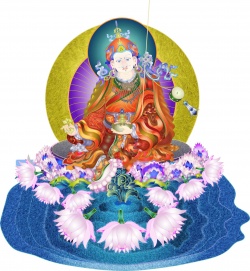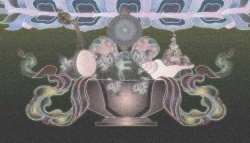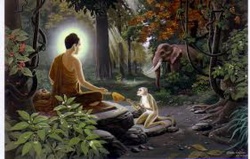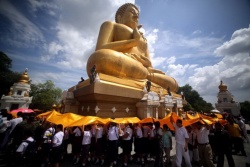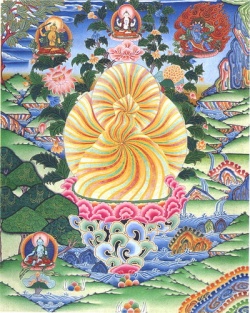Agharta And The Golden City Of Shambhala
As the Russian philosopher Nicholas Roerich passed through the sprawling mountains of Central Asia in 1926, he and his guides were shocked to witness an incredible, golden orb floating in the sky.
“…high up in the cloudless sky, they clearly saw a golden spheroidal object moving from the Altai Mountains to the north at tremendous speed. Veering sharply to the south-west, the golden sphere disappeared rapidly beyond the Humboldt Mountains.”
- from Chapter 4 of Invisible Eagle: The History of Nazi Occultism by Alan Baker
Perhaps Roerich shouldn’t have been surprised.
Some claim his journey was no mere expedition: He was attempting to return a fragment of the legendary Cintamani Stone to its rightful place at the center of Shambhala, and the golden sphere was a welcoming sign from within.
The Prophecies Of Shambhala
The legend of Shambhala can be found within the teachings of the Kalachakra, or “cycles of time,” of Tibetan Buddhism.
It is a “Pure Land,” a circular city in the shape of a lotus flower, that exists in a space between the physical and spiritual, perhaps within another dimension. It’s capital is known as Kalapa, which is located at the very center of the realm, where the King of the World awaits on his throne.
According to Buddhist teachings, this paradise is only accessible to those with pure intentions and “karmic association.”
Of course, many have attempted to locate Shambhala — most believe it lies within Inner Asia, perhaps in the Himalayas, or within an “etheric plane” somewhere in the Gobi Desert. Roerich himself claimed an entrance to Shambhala was connected via an underground passage to Lhasa, the capital of Tibet.
But Nicholas Roerich wasn’t the only one to seek entry into Shambhala; it is said the Nazis sought aid from the mythical city during their many expeditions to Tibet in the 1930s.
As far as the rest of us know, it was never found.
We are left, then, with only a prophecy:
When our world is engulfed in war and suffering, and all is lost, it is said the King of the World will rise from within Shambhala, along with a great army, and eradicate the darkness from the Earth. An age of peace and prosperity will follow.
The Gate To Agharta
Perhaps, however, there’s something more to these old stories and prophecies.
The book Beasts, Men and Gods by Ferdinand Ossendowski is an interesting memoir of Ossendowski’s experiences in Russia during the Russian Civil War, and his journey into Mongolia. But it’s not an ordinary tale.
In Chapter XLVI, “The Subterranean Kingdom}},” he tells of an incident in which his mongol guides stopped suddenly, dismounted their camels and began to pray, repeating the words, “Om Mani padme Hung!”
When they finished, one of them explained:
“‘Did you see,’ asked the Mongol, ‘how our camels moved their ears in fear? How the herd of horses on the plain stood fixed in attention and how the herds of sheep and cattle lay crouched close to the ground? Did you notice that the birds did not fly…
All living beings in fear are involuntarily thrown into prayer and waiting for their fate. So it was just now. Thus it has always been whenever the King of the World in his subterranean palace prays and searches out the destiny of all peoples on the earth.’”
Later in the book, Ossendowski learns of the “Mystery of Mysteries,” the legend of the Kingdom of Agharti. He’s shown a cave, or “smoking gate,” through which locals claimed an old tribe fled into a “subterranean country.”
Finally, after many questions, Ossendowski is granted the truth about this mystical realm of Agharti by the Prince Chultun Beyli:
“In it there is not much of the wonderful. You know that in the two greatest oceans of the east and the west, there were formerly two continents. They disappeared under the water, but their people went into the subterranean kingdom…
There are many different peoples and many different tribes…”
Recently, this strange place at the center of the Earth has come to be known as Agharta or Agartha.
Modern myth describes it as a place of technological wonder (including, perhaps, flying saucers), where high priests, scientists and supermen hold incredible power, similar to the civilizations described by the likes of Raymond Bernard and Olaf Jansen.
Agartha
Occassionaly, Shambhala is referred to as the capital city of Agharta, though this seems to be a purely Western construct. Entrances are said to exist at the Poles, or in caverns and tunnels honeycombed throughout the planet.
Some, like Bernard, believe this civilization is composed of the remnants of Lemuria and Atlantis, the two destroyed continents Ferdinand Ossendowski was told of.
Ossendowski was also told that the people of this realm hold the power to, if provoked, “explode the whole surface of our planet and transform it into desert.”
Do these myths and ancient legends of hidden realms and subterranean cities hold any truth?
If so, will the Prophecies of Shambhala come to pass?
As they say, time will tell.
